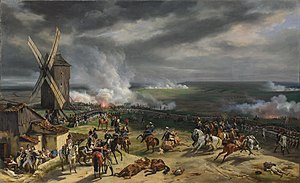Battle of Valmy
| The Battle of Valmy | |||||||
|---|---|---|---|---|---|---|---|
| Part of the French Revolutionary Wars | |||||||
 Painting of the battle of Valmy by Horace Vernet from 1826. The white-uniformed infantry to the right are regulars while the blue-coated ranks to the left represent the citizen volunteers of 1791 |
|||||||
|
|||||||
| Belligerents | |||||||
|
|
|
||||||
| Commanders and leaders | |||||||
|
|
|
||||||
| Strength | |||||||
| 32,000 | 34,000 | ||||||
| Casualties and losses | |||||||
| 300 | 184 | ||||||
The Battle of Valmy was the first major victory by the army of France during the Revolutionary Wars that followed the French Revolution. The action took place on 20 September 1792 as Prussian troops commanded by the Duke of Brunswick attempted to march on Paris. Generals François Kellermann and Charles Dumouriez stopped the advance near the northern village of Valmy in Champagne-Ardenne.
In this early part of the Revolutionary Wars—known as the War of the First Coalition—the new French government was in almost every way unproven, and thus the small, localized victory at Valmy became a huge psychological victory for the Revolution at large. The outcome was thoroughly unexpected by contemporary observers – a vindication for the French revolutionaries and a stunning defeat for the vaunted Prussian army. The victory emboldened the newly assembled National Convention to formally declare the end of monarchy in France and to establish the First French Republic. Valmy permitted the development of the Revolution and all its resultant ripple-effects, and for that it is regarded by historians as one of the most significant battles of all time.
As the French Revolution continued, the monarchies of Europe became concerned that revolutionary fervor would spread to their countries. The War of the First Coalition was an effort to stop the revolution, or at least contain it to France. King Frederick William II of Prussia had the support of Great Britain and the Austrian Empire to send the Duke of Brunswick towards Paris with a large army. In the war's early encounters of mid-1792, French troops did not distinguish themselves, and enemy forces advanced dangerously deep into France intending to pacify the country, restore the traditional monarchy, and end the Revolution. The French commander Charles Dumouriez, meanwhile, had been marching his army northeast to attack the Austrian Netherlands, but this plan was abandoned because of the more immediate threat to Paris. A second army under General François Kellermann was ordered to link up with him in a mutual defense.
...
Wikipedia
